Goldie Nejat
Embodied AI with Foundation Models for Mobile Service Robots: A Systematic Review
May 26, 2025Abstract:Rapid advancements in foundation models, including Large Language Models, Vision-Language Models, Multimodal Large Language Models, and Vision-Language-Action Models have opened new avenues for embodied AI in mobile service robotics. By combining foundation models with the principles of embodied AI, where intelligent systems perceive, reason, and act through physical interactions, robots can improve understanding, adapt to, and execute complex tasks in dynamic real-world environments. However, embodied AI in mobile service robots continues to face key challenges, including multimodal sensor fusion, real-time decision-making under uncertainty, task generalization, and effective human-robot interactions (HRI). In this paper, we present the first systematic review of the integration of foundation models in mobile service robotics, identifying key open challenges in embodied AI and examining how foundation models can address them. Namely, we explore the role of such models in enabling real-time sensor fusion, language-conditioned control, and adaptive task execution. Furthermore, we discuss real-world applications in the domestic assistance, healthcare, and service automation sectors, demonstrating the transformative impact of foundation models on service robotics. We also include potential future research directions, emphasizing the need for predictive scaling laws, autonomous long-term adaptation, and cross-embodiment generalization to enable scalable, efficient, and robust deployment of foundation models in human-centric robotic systems.
MLLM-Search: A Zero-Shot Approach to Finding People using Multimodal Large Language Models
Nov 27, 2024



Abstract:Robotic search of people in human-centered environments, including healthcare settings, is challenging as autonomous robots need to locate people without complete or any prior knowledge of their schedules, plans or locations. Furthermore, robots need to be able to adapt to real-time events that can influence a person's plan in an environment. In this paper, we present MLLM-Search, a novel zero-shot person search architecture that leverages multimodal large language models (MLLM) to address the mobile robot problem of searching for a person under event-driven scenarios with varying user schedules. Our approach introduces a novel visual prompting method to provide robots with spatial understanding of the environment by generating a spatially grounded waypoint map, representing navigable waypoints by a topological graph and regions by semantic labels. This is incorporated into a MLLM with a region planner that selects the next search region based on the semantic relevance to the search scenario, and a waypoint planner which generates a search path by considering the semantically relevant objects and the local spatial context through our unique spatial chain-of-thought prompting approach. Extensive 3D photorealistic experiments were conducted to validate the performance of MLLM-Search in searching for a person with a changing schedule in different environments. An ablation study was also conducted to validate the main design choices of MLLM-Search. Furthermore, a comparison study with state-of-the art search methods demonstrated that MLLM-Search outperforms existing methods with respect to search efficiency. Real-world experiments with a mobile robot in a multi-room floor of a building showed that MLLM-Search was able to generalize to finding a person in a new unseen environment.
The Future of Intelligent Healthcare: A Systematic Analysis and Discussion on the Integration and Impact of Robots Using Large Language Models for Healthcare
Nov 05, 2024Abstract:The potential use of large language models (LLMs) in healthcare robotics can help address the significant demand put on healthcare systems around the world with respect to an aging demographic and a shortage of healthcare professionals. Even though LLMs have already been integrated into medicine to assist both clinicians and patients, the integration of LLMs within healthcare robots has not yet been explored for clinical settings. In this perspective paper, we investigate the groundbreaking developments in robotics and LLMs to uniquely identify the needed system requirements for designing health specific LLM based robots in terms of multi modal communication through human robot interactions (HRIs), semantic reasoning, and task planning. Furthermore, we discuss the ethical issues, open challenges, and potential future research directions for this emerging innovative field.
4CNet: A Confidence-Aware, Contrastive, Conditional, Consistency Model for Robot Map Prediction in Multi-Robot Environments
Feb 27, 2024



Abstract:Mobile robots in unknown cluttered environments with irregularly shaped obstacles often face sensing, energy, and communication challenges which directly affect their ability to explore these environments. In this paper, we introduce a novel deep learning method, Confidence-Aware Contrastive Conditional Consistency Model (4CNet), for mobile robot map prediction during resource-limited exploration in multi-robot environments. 4CNet uniquely incorporates: 1) a conditional consistency model for map prediction in irregularly shaped unknown regions, 2) a contrastive map-trajectory pretraining framework for a trajectory encoder that extracts spatial information from the trajectories of nearby robots during map prediction, and 3) a confidence network to measure the uncertainty of map prediction for effective exploration under resource constraints. We incorporate 4CNet within our proposed robot exploration with map prediction architecture, 4CNet-E. We then conduct extensive comparison studies with 4CNet-E and state-of-the-art heuristic and learning methods to investigate both map prediction and exploration performance in environments consisting of uneven terrain and irregularly shaped obstacles. Results showed that 4CNet-E obtained statistically significant higher prediction accuracy and area coverage with varying environment sizes, number of robots, energy budgets, and communication limitations. Real-world mobile robot experiments were performed and validated the feasibility and generalizability of 4CNet-E for mobile robot map prediction and exploration.
LDTrack: Dynamic People Tracking by Service Robots using Diffusion Models
Feb 26, 2024Abstract:Tracking of dynamic people in cluttered and crowded human-centered environments is a challenging robotics problem due to the presence of intraclass variations including occlusions, pose deformations, and lighting variations. This paper introduces a novel deep learning architecture, using conditional latent diffusion models, the Latent Diffusion Track (LDTrack), for tracking multiple dynamic people under intraclass variations. By uniquely utilizing conditional latent diffusion models to capture temporal person embeddings, our architecture can adapt to appearance changes of people over time. We incorporated a latent feature encoder network which enables the diffusion process to operate within a high-dimensional latent space to allow for the extraction and spatial-temporal refinement of such rich features as person appearance, motion, location, identity, and contextual information. Extensive experiments demonstrate the effectiveness of LDTrack over other state-of-the-art tracking methods in cluttered and crowded human-centered environments under intraclass variations. Namely, the results show our method outperforms existing deep learning robotic people tracking methods in both tracking accuracy and tracking precision with statistical significance.
NavFormer: A Transformer Architecture for Robot Target-Driven Navigation in Unknown and Dynamic Environments
Feb 09, 2024



Abstract:In unknown cluttered and dynamic environments such as disaster scenes, mobile robots need to perform target-driven navigation in order to find people or objects of interest, while being solely guided by images of the targets. In this paper, we introduce NavFormer, a novel end-to-end transformer architecture developed for robot target-driven navigation in unknown and dynamic environments. NavFormer leverages the strengths of both 1) transformers for sequential data processing and 2) self-supervised learning (SSL) for visual representation to reason about spatial layouts and to perform collision-avoidance in dynamic settings. The architecture uniquely combines dual-visual encoders consisting of a static encoder for extracting invariant environment features for spatial reasoning, and a general encoder for dynamic obstacle avoidance. The primary robot navigation task is decomposed into two sub-tasks for training: single robot exploration and multi-robot collision avoidance. We perform cross-task training to enable the transfer of learned skills to the complex primary navigation task without the need for task-specific fine-tuning. Simulated experiments demonstrate that NavFormer can effectively navigate a mobile robot in diverse unknown environments, outperforming existing state-of-the-art methods in terms of success rate and success weighted by (normalized inverse) path length. Furthermore, a comprehensive ablation study is performed to evaluate the impact of the main design choices of the structure and training of NavFormer, further validating their effectiveness in the overall system.
Robots Autonomously Detecting People: A Multimodal Deep Contrastive Learning Method Robust to Intraclass Variations
Mar 01, 2022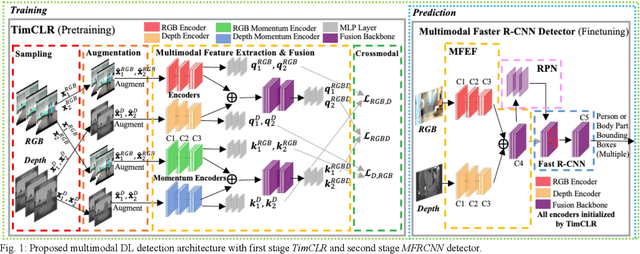
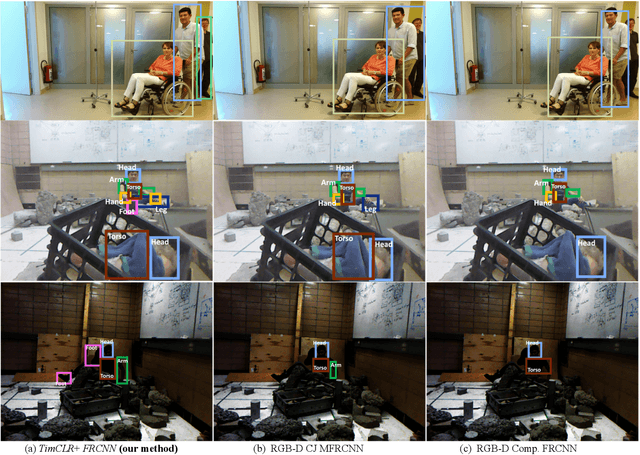

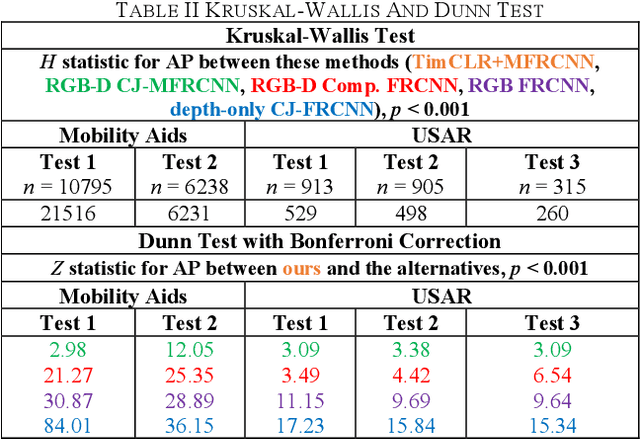
Abstract:Robotic detection of people in crowded and/or cluttered human-centered environments including hospitals, long-term care, stores and airports is challenging as people can become occluded by other people or objects, and deform due to variations in clothing or pose. There can also be loss of discriminative visual features due to poor lighting. In this paper, we present a novel multimodal person detection architecture to address the mobile robot problem of person detection under intraclass variations. We present a two-stage training approach using 1) a unique pretraining method we define as Temporal Invariant Multimodal Contrastive Learning (TimCLR), and 2) a Multimodal Faster R-CNN (MFRCNN) detector. TimCLR learns person representations that are invariant under intraclass variations through unsupervised learning. Our approach is unique in that it generates image pairs from natural variations within multimodal image sequences, in addition to synthetic data augmentation, and contrasts crossmodal features to transfer invariances between different modalities. These pretrained features are used by the MFRCNN detector for finetuning and person detection from RGB-D images. Extensive experiments validate the performance of our DL architecture in both human-centered crowded and cluttered environments. Results show that our method outperforms existing unimodal and multimodal person detection approaches in terms of detection accuracy in detecting people with body occlusions and pose deformations in different lighting conditions.
Deep Reinforcement Learning for Decentralized Multi-Robot Exploration with Macro Actions
Oct 05, 2021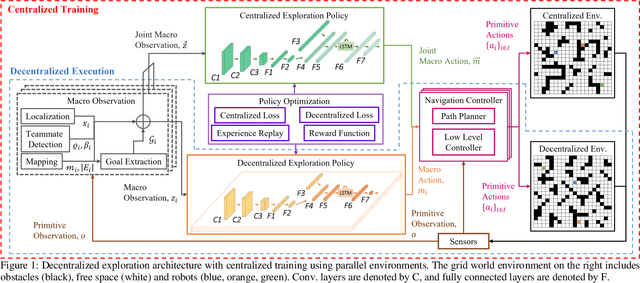
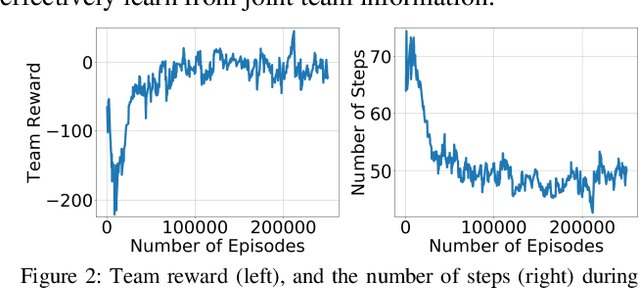
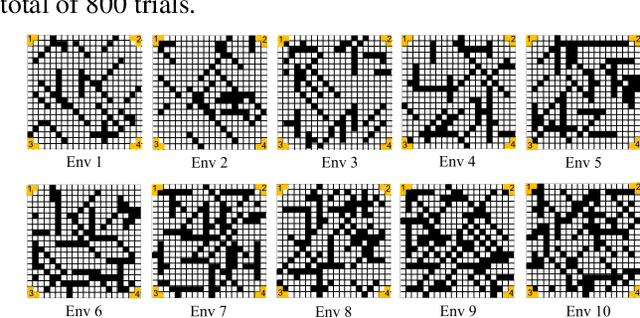
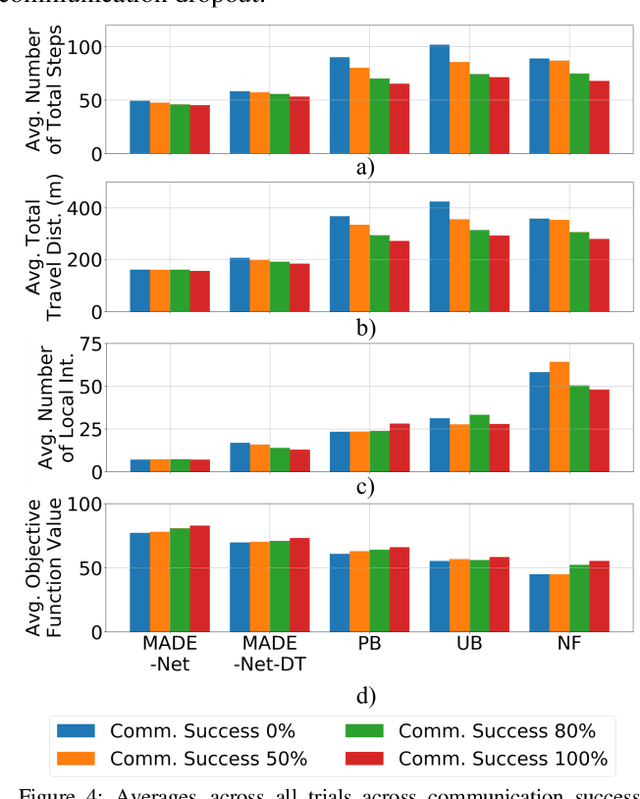
Abstract:Cooperative multi-robot teams need to be able to explore cluttered and unstructured environments together while dealing with communication challenges. Specifically, during communication dropout, local information about robots can no longer be exchanged to maintain robot team coordination. Therefore, robots need to consider high-level teammate intentions during action selection. In this paper, we present the first Macro Action Decentralized Exploration Network (MADE-Net) using multi-agent deep reinforcement learning to address the challenges of communication dropouts during multi-robot exploration in unseen, unstructured, and cluttered environments. Simulated robot team exploration experiments were conducted and compared to classical and deep reinforcement learning methods. The results showed that our MADE-Net method was able to outperform all benchmark methods in terms of computation time, total travel distance, number of local interactions between robots, and exploration rate across various degrees of communication dropouts; highlighting the effectiveness and robustness of our method.
Multimodal Detection of COVID-19 Symptoms using Deep Learning & Probability-based Weighting of Modes
Sep 03, 2021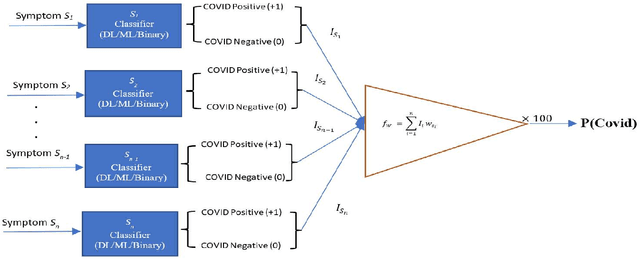
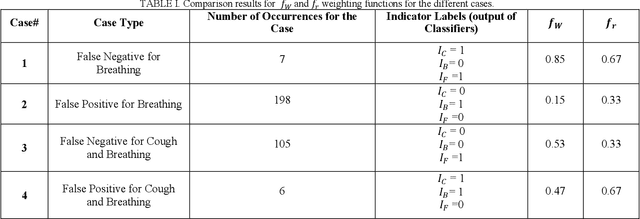
Abstract:The COVID-19 pandemic is one of the most challenging healthcare crises during the 21st century. As the virus continues to spread on a global scale, the majority of efforts have been on the development of vaccines and the mass immunization of the public. While the daily case numbers were following a decreasing trend, the emergent of new virus mutations and variants still pose a significant threat. As economies start recovering and societies start opening up with people going back into office buildings, schools, and malls, we still need to have the ability to detect and minimize the spread of COVID-19. Individuals with COVID-19 may show multiple symptoms such as cough, fever, and shortness of breath. Many of the existing detection techniques focus on symptoms having the same equal importance. However, it has been shown that some symptoms are more prevalent than others. In this paper, we present a multimodal method to predict COVID-19 by incorporating existing deep learning classifiers using convolutional neural networks and our novel probability-based weighting function that considers the prevalence of each symptom. The experiments were performed on an existing dataset with respect to the three considered modes of coughs, fever, and shortness of breath. The results show considerable improvements in the detection of COVID-19 using our weighting function when compared to an equal weighting function.
Robots Understanding Contextual Information in Human-Centered Environments using Weakly Supervised Mask Data Distillation
Dec 15, 2020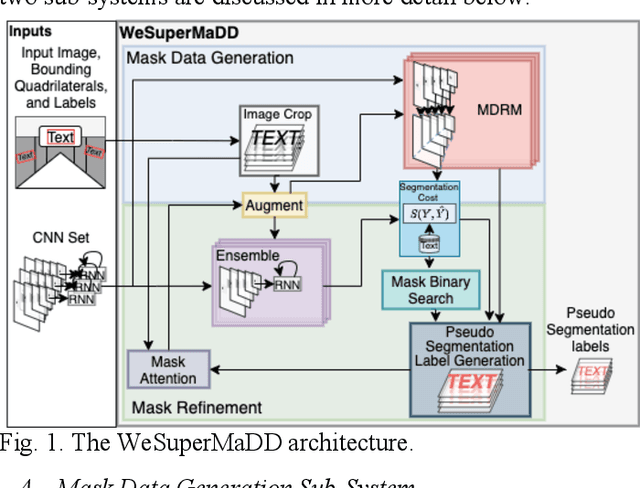
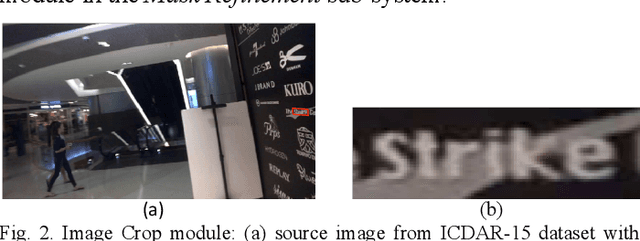

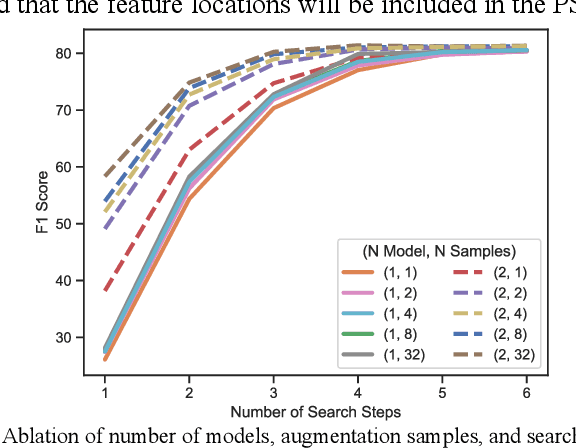
Abstract:Contextual information in human environments, such as signs, symbols, and objects provide important information for robots to use for exploration and navigation. To identify and segment contextual information from complex images obtained in these environments, data-driven methods such as Convolutional Neural Networks (CNNs) are used. However, these methods require large amounts of human labeled data which are slow and time-consuming to obtain. Weakly supervised methods address this limitation by generating pseudo segmentation labels (PSLs). In this paper, we present the novel Weakly Supervised Mask Data Distillation (WeSuperMaDD) architecture for autonomously generating PSLs using CNNs not specifically trained for the task of context segmentation; i.e., CNNs trained for object classification, image captioning, etc. WeSuperMaDD uniquely generates PSLs using learned image features from sparse and limited diversity data; common in robot navigation tasks in human-centred environments (malls, grocery stores). Our proposed architecture uses a new mask refinement system which automatically searches for the PSL with the fewest foreground pixels that satisfies cost constraints. This removes the need for handcrafted heuristic rules. Extensive experiments successfully validated the performance of WeSuperMaDD in generating PSLs for datasets with text of various scales, fonts, and perspectives in multiple indoor/outdoor environments. A comparison with Naive, GrabCut, and Pyramid methods found a significant improvement in label and segmentation quality. Moreover, a context segmentation CNN trained using the WeSuperMaDD architecture achieved measurable improvements in accuracy compared to one trained with Naive PSLs. Our method also had comparable performance to existing state-of-the-art text detection and segmentation methods on real datasets without requiring segmentation labels for training.
 Add to Chrome
Add to Chrome Add to Firefox
Add to Firefox Add to Edge
Add to Edge